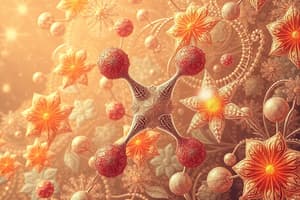Podcast
Questions and Answers
சைரலிட்டி என்றால் என்ன?
சைரலிட்டி என்றால் என்ன?
ஒரு தனிவகை பதக்கம் இல்லாத ஒரு அணு அல்லது பொருள்
சைரலிட்டி என்றால் என்ன?
சைரலிட்டி என்றால் என்ன?
மூலக்கருவியின் சைரல் கேன்டர்
எனாந்தியோமர்கள் என்றால் என்ன?
எனாந்தியோமர்கள் என்றால் என்ன?
சைரலிட்டி இல்லாத குறுக்கு பதக்கங்கள்
சைரல்டி அமின்களின் பயன்பாடு என்ன?
சைரல்டி அமின்களின் பயன்பாடு என்ன?
சைரல் மூலகங்கள் எப்படி தெரியும்?
சைரல் மூலகங்கள் எப்படி தெரியும்?
சைரல் கேட்டலிஸ்டுகள் பயன்பாடு என்ன?
சைரல் கேட்டலிஸ்டுகள் பயன்பாடு என்ன?
சைரல் மூலகமுகம் பிரமிப்பு அதிகமான பயன்கள் என்ன?
சைரல் மூலகமுகம் பிரமிப்பு அதிகமான பயன்கள் என்ன?
சைரல் பொருள்களின் விளைவுகளை அறிய முக்கியமானது என்ன?
சைரல் பொருள்களின் விளைவுகளை அறிய முக்கியமானது என்ன?
Flashcards are hidden until you start studying
Study Notes
Introduction
Chirality is a term used in the field of chemistry and mathematics to describe the absence of a plane of symmetry in a molecule or object. This lack of symmetry creates a pair of non-superimposable mirror images, which are known as enantiomers. Chirality is a fundamental concept in organic chemistry, as it plays a crucial role in the properties and behavior of many organic compounds.
Chirality and Organic Compounds
Organic compounds are molecules that contain carbon atoms bonded to hydrogen atoms. These molecules can have a wide range of properties and can be found in various states of matter, such as solids, liquids, and gases. Chirality is particularly important in the study of organic compounds because it affects their physical and chemical properties, including their stability, reactivity, and ability to form crystals.
Enantiomers
Enantiomers are mirror-image molecules that have the same molecular formula but different properties. They are created when a chiral molecule lacks a plane of symmetry, resulting in a pair of non-superimposable mirror images. Enantiomers often have different physical and chemical properties, such as melting points, boiling points, and solubility in various solvents. They can also exhibit different biological activities, making them useful in the development of pharmaceuticals and other medical treatments.
Chiral Centers
A chiral center is an atom or group of atoms within a molecule that creates a chiral molecule. These centers are typically carbon atoms bonded to four different substituents, which can be atoms or groups of atoms. Chiral centers play a crucial role in determining the chirality of a molecule and, consequently, the presence of enantiomers. They are also important in the synthesis and purification of chiral molecules, as they can be used as reference points for the separation of enantiomers.
Determining Chirality
Chirality can be determined using various methods, including X-ray crystallography, NMR spectroscopy, and chiral chromatography. These techniques allow chemists to study the structure of a molecule at the atomic level, identify chiral centers, and determine the presence of enantiomers. The identification of chirality is essential for understanding the properties and behavior of organic compounds and for the development of new synthetic methods.
Applications of Chirality in Organic Chemistry
Chirality plays a crucial role in various applications of organic chemistry, including:
-
Pharmaceuticals: Enantiomers often have different biological activities, making them useful in the development of drugs. By understanding the chirality of a molecule, chemists can design more effective and selective drugs.
-
Catalysis: Chiral catalysts can be used to selectively synthesize enantiomers, allowing for the production of single-enantiomer compounds. This is particularly important in the synthesis of pharmaceuticals and other high-value compounds.
-
Material Science: Chirality is also important in the study of materials with unique properties, such as liquid crystals and topological insulators. Understanding the chirality of these materials can lead to the development of new materials with advanced properties.
-
Forensic Science: Chirality can be used in the analysis of fingerprints, bloodstains, and other biological samples to identify individuals and establish evidence in criminal investigations.
In conclusion, chirality is a fundamental concept in organic chemistry that plays a crucial role in the properties and behavior of organic compounds. By understanding chirality, chemists can design more effective drugs, develop new catalysts, and study materials with unique properties. The study of chirality continues to be an active area of research in the field of organic chemistry and beyond.
Studying That Suits You
Use AI to generate personalized quizzes and flashcards to suit your learning preferences.




